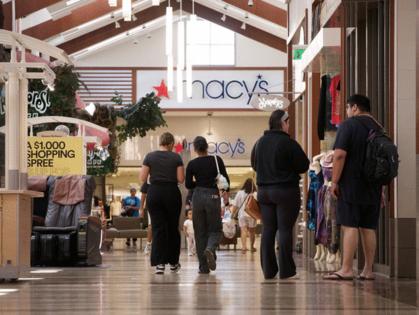Gurnee Mills announces new slate of businesses: 'The death of malls is vastly overrated'
Published in Business News
GURNEE, Illinois — Gurnee Mills, a mall located in a northern exurb of Chicago, recently announced a new slate of stores and businesses coming to the mall in the near future, a sign of its “thriving” health, according to shopping center representatives.
It’s a far cry from reports that came out about the mall leading up to the pandemic, and the upturn in recent years is a potential show of how some malls remain healthy in the era of e-commerce.
The 2 million square-foot mall, originally opened in 1991, found itself down a major anchor store with the loss of Sears Grand in 2018, and according to a 2020 report from American credit rating agency Fitch Ratings, it had a 79% occupancy rate by the end of 2019.
It’s a story in line with an overarching theme in the retail world at that time — increased use of online shopping and e-commerce appeared to be foreshadowing an eventual end to brick-and-mortar stores, especially those in malls. Then, the pandemic all but put a final nail in the coffin of the popularity of shopping malls.
But the numbers show that’s not necessarily true, according to Jim Schrager, clinical professor of entrepreneurship and strategy at the Chicago Booth School of Business.
“The death of malls is vastly overrated,” he said.
Despite the “hype” in the last 25 years, there’s been a “rather modest” amount of retail sales moving online, he said, increasing by a few percentages every year, before and after the pandemic. According to Federal Reserve Bank of St. Louis data, it currently sits at about 16%.
Today, Gurnee Mills has roughly 95% occupancy, Gurnee Mayor Tom Hood said during his January State of the Village address. Kelsey Castrejon, director of marketing and business development with Gurnee Mills, said in-person shopping is “thriving,” although she said it has evolved over the years with the rise of e-commerce.
Modern shoppers aren’t choosing between online and in-person, she said, “they’re actually using both, and often the two complement one another.”
Malls are “community centers,” Castrejon said, offering entertainment and events. And the “touch, try and buy” aspect of shopping can give shoppers “immediate gratification” that isn’t possible online, she said.
It’s an idea that Amanda Lai, a director with the Chicago-based retail consultancy McMillanDoolittle, also shared. Talk about how e-commerce would kill the mall hasn’t necessarily held true across the board. Coming out of the pandemic, even with e-commerce becoming more sophisticated, malls have still drawn people in, offering “third places” and “experiential areas to gather,” she said.
“It’s really about things you can’t replicate online,” Lai said. “That touching and feeling, service interactions, having a place to gather with friends and family — that’s what keeps people coming back in an age where it’s so easy to click what you want from your phone or laptop.”
That isn’t to say all malls are thriving. Certain styles of malls, such as enclosed malls, and older centers that haven’t been renovated, are struggling, she said. Those lacking “compelling, trendy or luxury tenants” and high vacancy rates are also facing challenges.
Schrager argued the basic factors remain the same for how well a mall will do: Location, management and anchor tenants. Do people still shop in the area? Is the mall being well-maintained and led? What stores do they offer?
Profitable retail in real and online spaces
While he personally likes online shopping, Schrager said there are, “many parts of the retail world that just don’t work online.”
The financial model is difficult for e-commerce, he said, since items need to be sufficiently expensive, like tech products, to justify the costs of shipping. He pointed to Amazon’s start as a bookseller, when he said it was losing money “hand over fist.”
“The basic economics of selling a book in a box and mailing it to me just don’t work,” Schrager said.
He also compared data from Barnes and Noble’s online and in-store sales profits. He said the data shows that online book selling “always lost money,” while the stores “always made money.” These “natural experiments,” as he called them, show how factors differ when selling in real space and internet space.
For the “vast amount of things sold retail,” it’s very hard to make money selling online, Schrager said, simply because the economics don’t work out. Meanwhile, malls over long periods of time are “generally profitable.”
Filling vacancies
Gurnee Mills announced eight new businesses in a recent news release: restaurant Hangry Cluck, women’s apparel store Just Cozy, claw machine arcade Kako Claw, clothing store Off the Rax, 3D print shop Pretty Pretty Print Press, clothing retailer Primark, trampoline park Sky Zone and seasonal specialty store Spirit Halloween.
Lai said malls in the modern age have looked to “creative” leasing to fill vacancies and bring some “newness” to the space, including smaller local businesses and shorter leases. Gurnee Mills’ list includes self-described “mom and pop shop” Pretty Pretty Print Press and seasonal store Spirit Halloween.
Looking ahead, as the last of the summer weather wanes, the shopping mall “Super Bowl” approaches, Castrejon said — the holiday season, with November and December seeing peak shopping traffic for the mall.
Not all the news for shopping malls is positive. There’s some uncertainty for malls in the future, Lai said, with the decline in international tourism. And Schranger said retail in general will see challenges with rising prices due to tariffs.
©2025 Chicago Tribune. Visit at chicagotribune.com. Distributed by Tribune Content Agency, LLC.












Comments